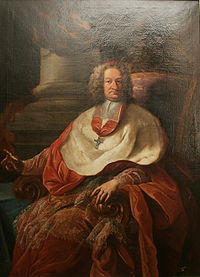- Count Leopold Anton von Firmian
-
 Contemporary portrait, Schloss Leopoldskron
Contemporary portrait, Schloss Leopoldskron
Leopold Anton Freiherr von Firmian or Leopold Anton Eleutherius von Firmian (11 March 1679 – 22 October 1744) was Catholic Bishop of Lavant 1718-1724, Bishop of Seckau 1724-1727 and Prince-Archbishop of Salzburg from 1727 until his death.
Family
He was born in Munich, on his father's side to the Freiherren (Barons) dynasty von Firmian descending from Sigmundskron (Formigar) Castle in Tyrol, by virtue of being the son of Countess Maria Viktoria von Thun and the Imperial envoy Franz Wilhelm Freiherr von Firmian. His maternal uncle Count Johann Ernst von Thun was Bishop of Seckau from 1679 until 1687 and Prince-Archbishop of Salzburg from 1687 to 1709.
Leopold Anton von Firmian was the uncle of cardinal Leopold Ernst von Firmian, also prince-bishop of Passau. His nephew, Karl Joseph von Firmian, the Austrian plenipotentiary minister in Milan, was renowned as a patron of the arts, including poets such as Giuseppe Parini, musicians such as Johann Ernst Eberlin and painters such as Giambettino Cignaroli. While Leopold Anton was an early patron of Leopold Mozart; the nephew, count Karl Firmian appears to have been one of the patrons for Amadeus Mozart's opera in Milan: Mitridate, Re di Ponto circa 1770.
Reign
Firmian had prepared for an ecclesiastical career, received his ordination in Rome in 1707 and became provost of the Salzburg chapter in 1713. Pope Clement XI appointed him Bishop of Lavant in 1718, Pope Benedict XIII also made him Bishop of Seckau in 1724. On 4 October 1727 he was elected Archbishop of Salzburg. He had Schloss Klessheim finished and Schloss Leopoldskron erected as his private residence.
On a darker note, Firmian was a fierce advocate of the Counter-Reformation pursued in his Salzburg lands by the Jesuit order, who however could not prevail against widespread Crypto-protestantism. On October 31, 1731, the 214th anniversary of Martin Luther's nailing of his 95 Theses to the Wittenberg School door, Archbishop Count Leopold Anton von Firmian signed an Edict of Expulsion of Protestants[1] contradicting the 1648 Peace of Westphalia, declaring that all Protestants in the bishopric of Salzburg were rebels, who had to recant their non-Catholic beliefs or be banished within days. To the archbishop's surprise, over 20 thousand citizens professed Protestant beliefs and were exiled. Many of those who survived the flight were received by King Frederick William I of Prussia and settled around Gumbinnen in the East Prussian province. Others, including the miller Petrus Wimbisfelder, settled in the estuary of the river Schelde, near the coast of Zeeuws Vlaanderen - a part of the province of Zeeland in the Netherlands. The expulsion caused vehement protest by the Protestant Imperial Estates and did severe damage to Salzburg's economy.
Archbishop Firmian is buried at the crypt of Salzburg Cathedral.
External links
- Friedrich Wilhelm Bautz (1990). Bautz, Friedrich Wilhelm. ed (in German). Firmian, Leopold Anton Freiherr von. Biographisch-Bibliographisches Kirchenlexikon (BBKL). 2. Hamm. cols. 36–38. ISBN 3-88309-032-8. http://www.bautz.de/bbkl/f/firmian_l_a.shtml.
- Edict of Expulsion of Protestants (German)
Categories:- 18th-century Austrian people
- 18th-century Roman Catholic archbishops
- Roman Catholic archbishops of Salzburg
- Austrian bishops
- Austrian nobility
- Firmian family
- Austrian expatriates in Germany
- People from Munich
- 1679 births
- 1744 deaths
Wikimedia Foundation. 2010.
